It’s been a long time since I last published an entry. It was painful to be gone, and I’m glad to be back. Perhaps I’ll devote an entry to my excuses, but for now I thought I’d share a few of my favorite things, culled from images taken while I was “gone.”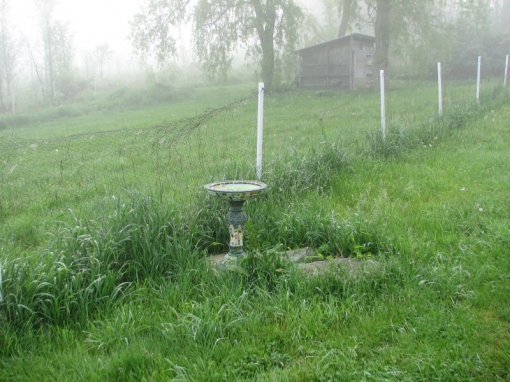 This is the bird bath I agonized over in February. Some readers requested I post a photo of it in situ. It is resting on the lid of the septic tank, which is one of the few level, perfectly flat sites on our property. You see, this all started with me trying to figure out a way to deal with the septic tank lid. How do you make a circular piece of concrete seem like an integral part of the garden, and yet maintain the kind of access to it that a large tank truck would require? I envisioned a garden that had ground covers that could tolerate foot traffic immediately surrounding the lid, gradually rising in height on either side. The bird bath was meant to be acquired after the flowers were established, the piece de resistance, the crowning touch. Only somehow I got the last, first. And knowing my life, and seeing how the garden I already have is faring, the “first” may never come. Perhaps I’ll eventually find a new place for the birdbath and ignore the septic tank lid. Thus far into the summer, precisely one bird has been seen taking advantage of the facilities. Oh well, I still like it. . .
This is the bird bath I agonized over in February. Some readers requested I post a photo of it in situ. It is resting on the lid of the septic tank, which is one of the few level, perfectly flat sites on our property. You see, this all started with me trying to figure out a way to deal with the septic tank lid. How do you make a circular piece of concrete seem like an integral part of the garden, and yet maintain the kind of access to it that a large tank truck would require? I envisioned a garden that had ground covers that could tolerate foot traffic immediately surrounding the lid, gradually rising in height on either side. The bird bath was meant to be acquired after the flowers were established, the piece de resistance, the crowning touch. Only somehow I got the last, first. And knowing my life, and seeing how the garden I already have is faring, the “first” may never come. Perhaps I’ll eventually find a new place for the birdbath and ignore the septic tank lid. Thus far into the summer, precisely one bird has been seen taking advantage of the facilities. Oh well, I still like it. . .
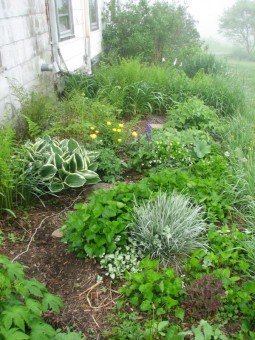 Here is the garden on the north side of the house. This garden pleases me mightily in spring. I like how the variegated oat grass plays off the emerging ‘Francee’ hosta and the ‘White Nancy’ lamium. You can see the pure yellow globe flower towards the back. That yellow is always somewhere in my garden, from daffodils and forsythia, to globe flowers, to red-sepaled evening primrose and now to daylilies, ‘Suzie Wong’ and ‘Butterpat,’ ‘Hyperion’ just starting, ‘Lemon Cap’ soon to follow, plus others whose tags I’ve lost. There used to be a lot of primulas in this bed, but many are gone, and the ones that are left are a shadow of their former selves. Surely last summer’s heat and drought didn’t help. Then last December, the first part of the month was mild enough to bring the primroses into bud, followed by the only sub-zero temperatures we had last winter. I think that’s what killed many of them. Many plants that can take bone-chilling cold when they’re dormant are knocked flat by those same conditions when they are in active growth.
Here is the garden on the north side of the house. This garden pleases me mightily in spring. I like how the variegated oat grass plays off the emerging ‘Francee’ hosta and the ‘White Nancy’ lamium. You can see the pure yellow globe flower towards the back. That yellow is always somewhere in my garden, from daffodils and forsythia, to globe flowers, to red-sepaled evening primrose and now to daylilies, ‘Suzie Wong’ and ‘Butterpat,’ ‘Hyperion’ just starting, ‘Lemon Cap’ soon to follow, plus others whose tags I’ve lost. There used to be a lot of primulas in this bed, but many are gone, and the ones that are left are a shadow of their former selves. Surely last summer’s heat and drought didn’t help. Then last December, the first part of the month was mild enough to bring the primroses into bud, followed by the only sub-zero temperatures we had last winter. I think that’s what killed many of them. Many plants that can take bone-chilling cold when they’re dormant are knocked flat by those same conditions when they are in active growth.
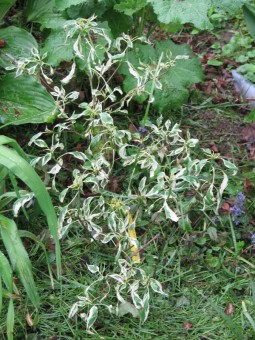 Here on the right is my second attempt to grow the beautiful variegated pagoda dogwood, Cornus alternifolia ‘Argentea.’ The first time I bought it, I was so anxious to make sure I got one that I sent my order in early to Roslyn Nursery, which is located on Long Island, and a few hardiness zones warmer than my garden. It arrived several weeks before my last frost, and I had to keep it in its pot and coddle it the whole time. Also it was quite small, about half the height of the one you see here, and cost thirty-five bucks. It never seemed to get any bigger, and didn’t make it through its second winter, despite supposedly being hardy to Zone 4. According to their catalog, plant sizes, and prices, get bumped up to the next tier on June 15. So this year I waited until the end of May to place my order, gambling that they still had the plant in stock, and was rewarded with a much bigger, more robust plant–still for thirty-five bucks. (The fact that I ordered my first one five years ago and the price hadn’t risen since then may explain why there is a notice on their website that they are no longer taking mail orders and their retail store is closed. How could any business enterprise go five years without raising prices and remain solvent?) I can’t tell you how happy I was when I unwrapped it from its packaging and saw its wonderful size and health. I felt like doing a Snoopy dance! I planted it immediately and it is thriving. Long may it prosper. Unfortunately, this shrub is planted in the same location as the poorly rooted double snowdrops I mentioned this spring. At the time, I thought a rabbit had been tunneling through this bed. About two weeks ago, I walked over to that area of the garden, and heard running water. Apparently, when the soil is saturated, an underground rivulet runs through one corner of the bed. I just now walked over there and pulled away the mulch, and sure enough, the tunnel I laboriously filled in this spring is back. The dogwood is planted uphill of this channel, but perhaps I should consider moving it yet further uphill.
Here on the right is my second attempt to grow the beautiful variegated pagoda dogwood, Cornus alternifolia ‘Argentea.’ The first time I bought it, I was so anxious to make sure I got one that I sent my order in early to Roslyn Nursery, which is located on Long Island, and a few hardiness zones warmer than my garden. It arrived several weeks before my last frost, and I had to keep it in its pot and coddle it the whole time. Also it was quite small, about half the height of the one you see here, and cost thirty-five bucks. It never seemed to get any bigger, and didn’t make it through its second winter, despite supposedly being hardy to Zone 4. According to their catalog, plant sizes, and prices, get bumped up to the next tier on June 15. So this year I waited until the end of May to place my order, gambling that they still had the plant in stock, and was rewarded with a much bigger, more robust plant–still for thirty-five bucks. (The fact that I ordered my first one five years ago and the price hadn’t risen since then may explain why there is a notice on their website that they are no longer taking mail orders and their retail store is closed. How could any business enterprise go five years without raising prices and remain solvent?) I can’t tell you how happy I was when I unwrapped it from its packaging and saw its wonderful size and health. I felt like doing a Snoopy dance! I planted it immediately and it is thriving. Long may it prosper. Unfortunately, this shrub is planted in the same location as the poorly rooted double snowdrops I mentioned this spring. At the time, I thought a rabbit had been tunneling through this bed. About two weeks ago, I walked over to that area of the garden, and heard running water. Apparently, when the soil is saturated, an underground rivulet runs through one corner of the bed. I just now walked over there and pulled away the mulch, and sure enough, the tunnel I laboriously filled in this spring is back. The dogwood is planted uphill of this channel, but perhaps I should consider moving it yet further uphill.
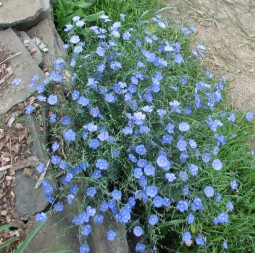 Here is another one of my favorites–perennial flax (Linum perenne). The camera isn’t lying: those true-blue flowers are just as blue in person. It starts blooming with the tulips; in fact, I used to have some ‘Burgundy Lace’ tulips growing nearby, and they looked wonderful with the flax. I thought a tulip with red leaning towards orange (scarlet) blossoms would look even better. It is still blooming as I write this, but I’ve never seen it bloom the whole summer. I’m not sure whether it is heat or drought that usually stops it. It is easy to grow from seed–it is often included in “wildflower” mixes–but it often doesn’t pull through the winter. I have noticed that it is more likely to come back if planted in especially well-draining soil. One other thing you should know: the flowers are gone by mid-afternoon. There is a new crop every morning, but the petals shrivel up in the hot noon sun and drop cleanly.
Here is another one of my favorites–perennial flax (Linum perenne). The camera isn’t lying: those true-blue flowers are just as blue in person. It starts blooming with the tulips; in fact, I used to have some ‘Burgundy Lace’ tulips growing nearby, and they looked wonderful with the flax. I thought a tulip with red leaning towards orange (scarlet) blossoms would look even better. It is still blooming as I write this, but I’ve never seen it bloom the whole summer. I’m not sure whether it is heat or drought that usually stops it. It is easy to grow from seed–it is often included in “wildflower” mixes–but it often doesn’t pull through the winter. I have noticed that it is more likely to come back if planted in especially well-draining soil. One other thing you should know: the flowers are gone by mid-afternoon. There is a new crop every morning, but the petals shrivel up in the hot noon sun and drop cleanly.
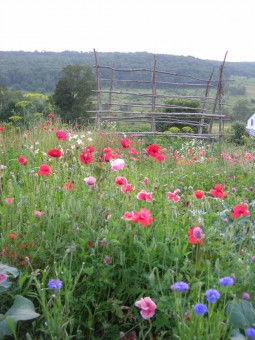
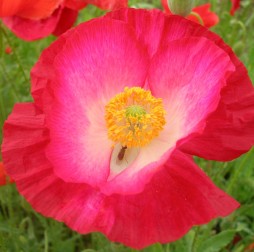
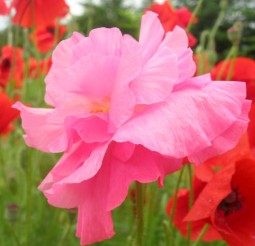
Believe it or not, this is a scene from our vegetable garden. Talitha allows these field poppies (Papaver rhoeas) to self sow in the parts of the garden not currently growing vegetables. The original plants were Shirley poppies, so called because they were selected by a Reverend Wilks living in Shirley, England for a variety of traits not normally seen in field poppies. Many of these have reverted, but there are still a few gorgeous ones here and there. I’m not sure how we got the double ones. In the background you can see the Trellis That Talitha Built. I hope one day she’ll have time to tell you the whole story herself. This trellis is meant to support the indeterminate tomatoes that in other years either toppled their wire cages or were left to sprawl on the ground. Tired of sharing tomatoes with slugs and rodents, or losing them to rot, she decided to find a better way.
So these are some of the things I wanted to tell you about while I was otherwise occupied. I hope to get back to website maintenance and blog reading gradually. For now, it’s good to be writing again.




I came by way of Mr Brown Thumb and read your post about agonizing over the purchase of the bird bath. I’m glad you bought it. I too often regret not “splurging” on something that struck my fancy.
I still have it. I still enjoy it. And I still have plans to plant phlox around it.
I love the story of the birdbath. I assume a year later you still have it and still enjoy owning it?
What pretty poppies! I`ve only just discovered your blog not long ago. Hope you stick around.
Zoey, I think you misread my post. The flax starts blooming in May. The individual flowers only last for a day, but the plant blooms for more than two months.
What a beautiful field of poppies! It is amazing how creative we get around the septic tank lids. Your birdbath looks great there. I like perennial flax too but I haven’t had luck with it where I garden now. Your north side garden is chock full of goodies. Glad you are back!
Kathy,
I have been wondering where you were. I was quite excited to see a new post today.
I have admired that perennial flax this spring at my local nursery. They had it planted with purple allium…quite a stunning display. I did not realize that the petals closed up in May.
That field of poppies is beautiful. Do I see bachelor buttons in there, too? The trellis is a giant! I will be interested to hear more about it.
How clever to use the top of the septic tank for the birdbath. I hope more birds find that upscale drinking fountain you have so kindly provided for them.
Your gardens are lovely- what beautiful poppies, and a splendid soultion for the septic tank lid!
Phlox would be good there, thanks for the idea!
Your birdbath is lonely for some phlox!
Glad to hear from you again. We get so busy/ distracted/ pulled away sometimes. And then when we get back, it’s the green of the garden we want to bask in, not the glare of the monitor…
Be well!
Beautiful pictures! Thank you for the lead on perennial flax. I love blue flowers, and having something blue that will bloom with tulips here in Zone 5 is worth seeking out!